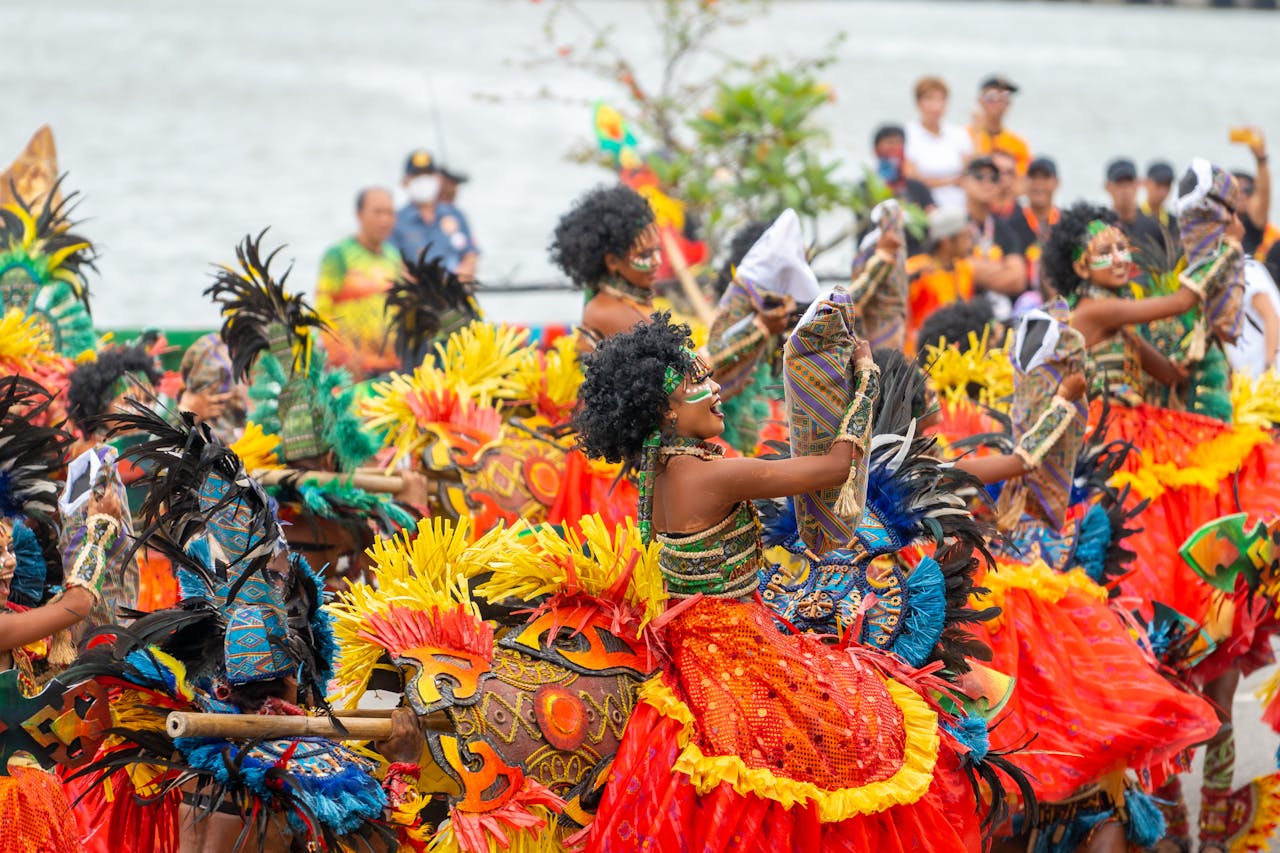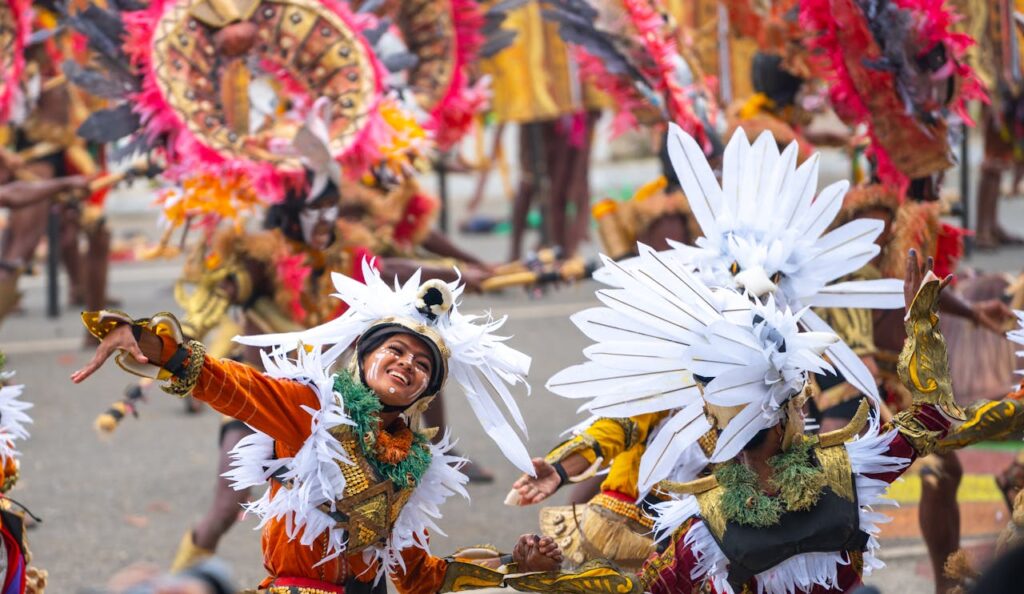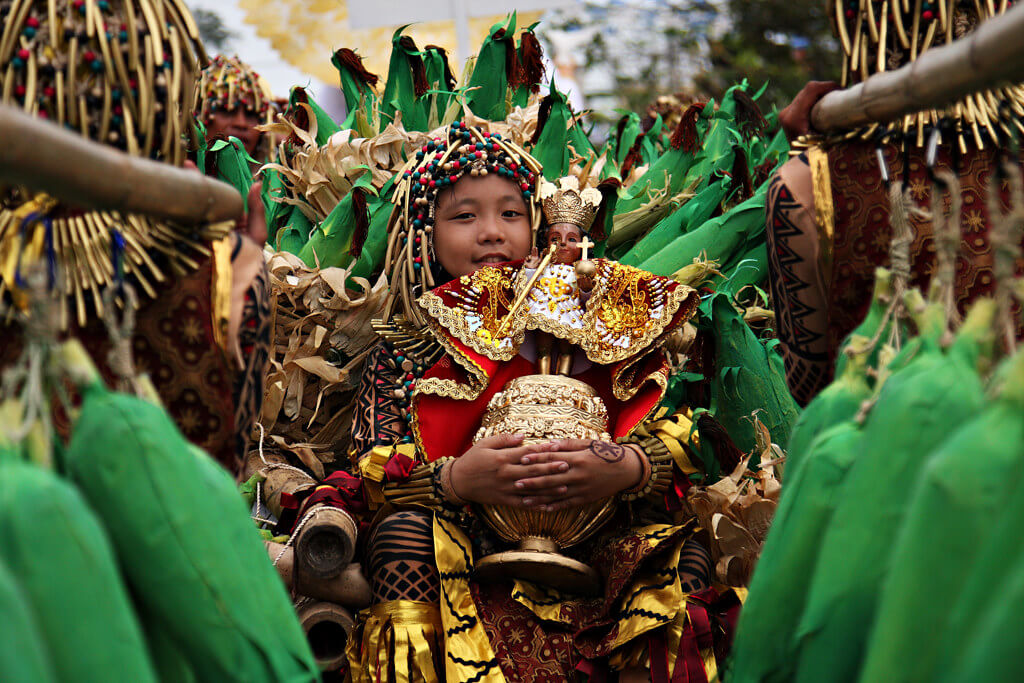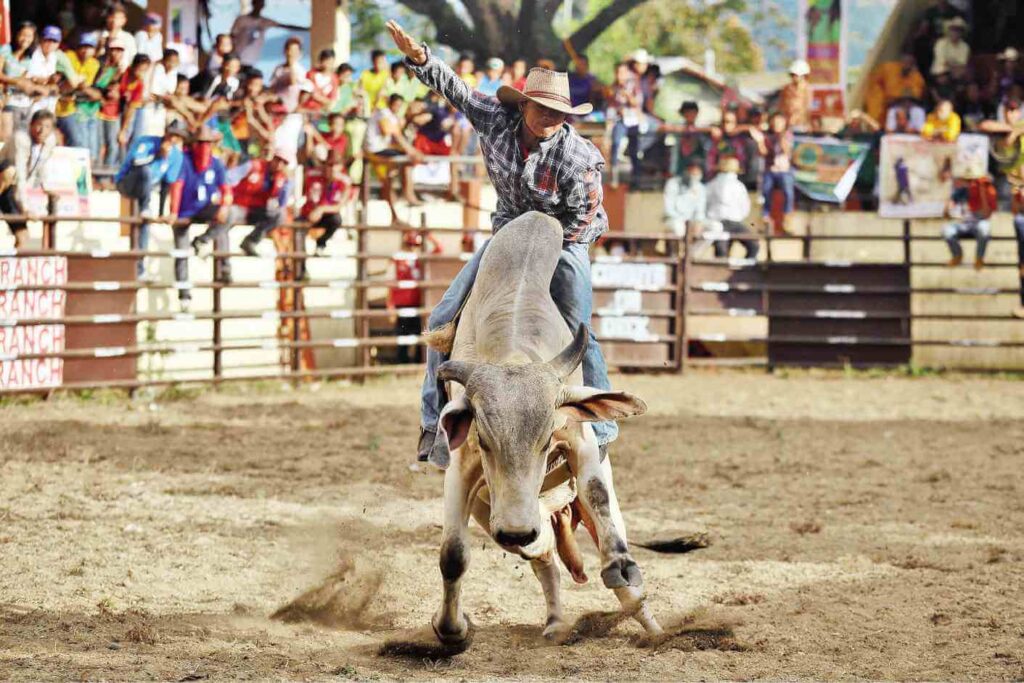The Vibrant Ati-Atihan Celebration
Origins and Significance
The Ati-Atihan Festival Dance, known as the “Mother of All Philippine Festivals,” is considered the oldest and wildest celebration in the Philippines. It all started way back in the day, inspired by the interaction between Malay chieftains led by Datu Puti and the Ati people, as narrated in the epic Maragtas. The festival celebrates the trade and camaraderie between these groups and emphasizes themes of gratitude and generosity.
During this lively festivity in Kalibo, participants smear their faces with black soot and don colorful costumes. The week-long party reaches its peak on the third Sunday of January in honor of Santo Niño.
Inspiration for Other Festivals
The Ati-Atihan Festival has made such a splash that it’s inspired other famous Philippine festivals like Dinagyang of Iloilo and Sinulog of Cebu, solidifying its status as a cultural heavyweight. It’s no joke when they call it the “Mother of All Philippine Festivals.”
Since the 1950s, Ati-Atihan has taken bits and pieces from Brazilian Carnival and New Orleans Mardi Gras, adding its own Filipino twist. The festival became more commercialized in the 1960s, thanks to the Philippine Department of Tourism’s promotional efforts (Wikipedia).
| Festival | Inspired by Ati-Atihan? (Yes/No) |
|---|---|
| Dinagyang | Yes |
| Sinulog | Yes |
| Panagbenga | No |
| MassKara | No |
The ati-atihan festival costumes are one of the many highlights, with elaborate designs that catch every eye. The festival’s influence even earned it a spot in the UNESCO-backed book “Pinagmulan: Enumeration from the Philippine Inventory of Intangible Cultural Heritage,” cementing its place in Filipino heritage.
The enduring popularity and vibrancy of Ati-Atihan provide a fantastic example of how traditions evolve and adapt, making it one of the most beloved festivals in the Philippines. Dive deeper into its history and roots here and discover why it’s such an essential part of Filipino culture.
Participating in the Festivities
The hallmark of the Ati-Atihan Festival lies in its lively participation, where everyone, from locals to tourists, can revel in the merrymaking. Whether donning elaborate costumes or joining in on traditional shouts and dances, the energy is infectious.
Elaborate Costumes and Accessories
Participants in the Ati-Atihan Festival are known for their flamboyant and colorful costumes, which are meticulously crafted to reflect traditional Ati clothing. These outfits feature intricate patterns and bright hues made of cloth, feathers, beads, and various decorative elements. Handmade with great care, these costumes often take weeks or even months to create, ensuring that no detail is overlooked (HICAPS).
The ati-atihan festival costumes typically include:
- Cloth Patterns: Vibrant textiles showcasing traditional designs.
- Feathers: Adding a touch of grandeur and volume to the attire.
- Beads and Sequins: Creating eye-catching sparkle.
- Body Paint: Enhancing the overall visual impact.
Traditional Shouts and Dances
The Ati-Atihan Festival dances are energetic and joyous, deeply rooted in the cultural heritage of the Ati people. The term “Ati-Atihan” itself comes from the Hiligaynon language, combining “Ati” (referring to the indigenous Ati people) with “Atihan” (meaning “to make a noise” or “to make a commotion”) (HICAPS). During the festival, participants embody this spirit of celebration with traditional shouts and dances.
Traditional Phrases and Their Meanings:
- “Hala Bira!” – “dispense all means!”
- “Viva Señor Santo Niño!” – Expressing joy and devotion to Santo Niño.
The lively atmosphere is accentuated by the repetitive shouting of these phrases, which rally the crowd and create a sense of unity and excitement. The dances themselves are a blend of rhythmic movements inspired by the Ati tribe’s ancestral rituals, performed to the beat of drums and other traditional instruments. For a deeper dive into the musical elements, check out ati-atihan festival music.
To partake in these festivities ensures an experience like no other, allowing individuals to fully immerse themselves in the jubilant and powerful cultural expressions of the Ati-Atihan Festival. For more details on various festival activities, visit ati-atihan festival activities.
| Aspect | Details |
|---|---|
| Costumes | Intricate, colorful, featuring feathers, beads, and body paint |
| Shouts | “Hala Bira!” and “Viva Señor Santo Niño!” |
| Dances | Rhythmic, energetic, inspired by traditional Ati rituals |
The Ati-Atihan Festival offers a unique and spirited opportunity to celebrate alongside the community, embracing the vibrant customs and traditions that make this event truly special.

Photo by Joel Garcia
Evolution of the Ati-Atihan Festival
Who would have thought that a festival originally designed to honor the Ati people would evolve into a massive cultural explosion? Let’s dive into how the Ati-Atihan Festival dance has become what it is today.
Integration of Ati People in Dances
Initially, the Ati-Atihan festival dance were performed by non-Ati natives who wanted to show their gratitude towards the Ati people. Imagine that! You throw a party for someone and you don’t even invite them to dance! Over the years, however, the Ati people themselves started to take part in the dances, blending their unique styles and cultural expressions into the festivities. This integration has made the dances more authentic and vibrant, turning the streets of Kalibo into a cultural melting pot of joyful movement.
If you’re interested in the evolution of these magnificent attires, check out our section on ati-atihan festival costumes.
UNESCO Recognition and Cultural Heritage
In 2012, the Ati-Atihan Festival got itself a cultural badge of honor. It was included in the first edition of the UNESCO-backed book “Pinagmulan: Enumeration from the Philippine Inventory of Intangible Cultural Heritage”. Talk about leveling up!
This recognition by the National Commission for Culture and the Arts (NCCA) and the ICHCAP of UNESCO marked the festival as a significant aspect of Philippine intangible cultural heritage. This also opened doors for its potential nomination to the prestigious UNESCO Intangible Cultural Heritage Lists.
| Event | Description |
|---|---|
| Year | 2012 |
| Recognition | Inclusion in “Pinagmulan: Enumeration from the Philippine Inventory of Intangible Cultural Heritage” |
| Significance | Marked as significant Philippine intangible cultural heritage by NCCA and ICHCAP of UNESCO |
| Future Potential | Nomination to UNESCO Intangible Cultural Heritage Lists |
For more juicy details on the history and evolution of this vibrant celebration, check out our article on ati-atihan festival history.
With every beat of the drum and every lively step, the Ati-Atihan festival continues to dance its way into the hearts of many, celebrating culture, community, and a whole lot of rhythm! Dive into more details about festival activities and music in our section on ati-atihan festival activities and ati-atihan festival music.
Festivities and Parades
The Ati-Atihan Festival dance is a sensory explosion of color, sound, and movement. The streets of Kalibo transform into a vibrant canvas of energetic celebrations and lively parades.
Religious Processions and Image Carrying
One of the heartwarming traditions of the Ati-Atihan Festival is the procession where thousands of participants carry different images of the Santo Niño. Held on the final day, this grand event happens on the third Sunday of January. The images are meticulously adorned and invoke a deep sense of reverence among the spectators and participants alike. The procession is a heartfelt homage to the Ati people, the indigenous inhabitants of the island of Panay, and serves as a way to give thanks and seek continued protection.
Here’s a glimpse into the procession:
| Aspect | Detail |
|---|---|
| Primary Day | Third Sunday of January |
| Participants | Thousands carrying Santo Niño images |
| Significance | Honoring and seeking protection from Santo Niño |
Visit our pages for more on the history of the Ati-Atihan Festival and its significance.
Colorful Street Parades and Sadsad Dance
The fiesta is incomplete without the vibrant street parades and spirited Sadsad Dance. Participants don elaborate and colorful costumes inspired by traditional Ati attire. These stunning outfits are handmade with intricate patterns and bright colors made of cloth, feathers, beads, and other decorative elements. Preparations for these costumes can take weeks or even months, reflecting the devotion and excitement of the festival-goers.
The Sadsad Dance is a pivotal part of the parade. This dance is more than just steps; it’s an expression of joy, an invitation to everyone to join in the merrymaking. Unlike traditional choreographed dances, the Sadsad is free-form, allowing dancers to groove to the infectious drumbeats in their unique style.
| Parade Element | Detail |
|---|---|
| Costume Materials | Cloth, feathers, beads, decorative elements |
| Dance Style | Free-form Sadsad Dance |
| Key Feature | Participation in energetic street parades |
To learn more about the music accompanying these festivities, explore Ati-Atihan Festival Music.
Dive into the lively world of the Ati-Atihan Festival, where every corner echoes with the beats of traditional drums, and every participant becomes a part of the spirited celebration of culture and history. For additional activities and experiences, see Ati-Atihan Festival Activities.
Cultural Fusion and Commercialization
The Ati-Atihan Festival isn’t just your average festival; it’s an epic party that blends various cultural elements with a healthy dose of commercial flair. Let’s dance through the details of how it has evolved over the years.
Incorporation of Carnival and Mardi Gras Elements
In the 1950s, the Ati-Atihan Festival began to incorporate aspects from two of the world’s most vibrant celebrations: the Brazilian Carnival and New Orleans’ Mardi Gras (Wikipedia). Picture this: drumbeats with a samba vibe, feathered costumes that rival those of Mardi Gras, and a level of energy that can only be described as electrifying. The infusion of these elements has turned the festival into a kaleidoscope of colors, music, and dance that captivates both locals and tourists.
This cultural mash-up has made the festival more accessible and appealing to a broader audience. It’s like having a slice of Brazil and New Orleans right in the heart of the Philippines. And who doesn’t love a little cultural cross-pollination when it means more fun for everyone?
| Elements | Description |
|---|---|
| Brazilian Carnival | Samba drumbeats, vibrant parades, and elaborate costumes |
| New Orleans Mardi Gras | Feathered masks, jazz music, and exuberant street parties |
Promotion and Adoption of Elaborate Costumes
In the 1960s, the Philippine Department of Tourism began promoting the Ati-Atihan Festival more aggressively, turning it into a national event (Wikipedia). Along with this push came the adoption of elaborate costumes inspired by tribal attire from various cultures. These costumes are not just outfits; they’re wearable art. Think intricate beading, vibrant feathers, and headdresses that reach for the sky.
The festival’s commercialization led to an explosion of creativity among participants. People go all out, designing costumes that are more dazzling each year. These elaborate outfits add a visual feast to the already exuberant celebrations, making the streets of Kalibo sparkle with every step of the ati-atihan festival dance. This dazzling display of tribal-inspired attire isn’t just about aesthetics; it’s a nod to the festival’s roots and the diverse cultures it celebrates.
If you’re curious about the details, check out our rundown on ati-atihan festival costumes for inspiration.
| Item | Description |
|---|---|
| Tribal Headdresses | Adorned with feathers and beads |
| Intricate Beading | Added to costumes for extra flair |
| Vibrant Feathers | Commonly seen in elaborate costumes |
Want to dive deeper into the history and music of the festival? Our articles on ati-atihan festival history and ati-atihan festival music have got you covered.
Whether you’re in it for the dance, the culture, or just the pure spectacle, the Ati-Atihan Festival has something for everyone. And let’s be honest, who wouldn’t want to get jiggy at a celebration like this?
Joyous Festivities in Kalibo
Kalibo comes alive with vibrant energy and joy during the Ati-Atihan Festival, an annual bash that turns the city into a massive street party. Let’s dive into some of the key highlights of this festival that make it a must-attend event in the Philippines.
Santo Niño Tributes and Street Parties
The centerpiece of the Ati-Atihan Festival is the solemn yet joyful tribute to the Santo Niño, or the Holy Child. This tribute takes place amid an atmosphere that’s nothing short of electric. Imagine dancing through the streets, surrounded by elaborately costumed revelers and ear-splitting drumbeats (Wanderlass).
- Street Parties: As the saying goes, “The night is young!” For an entire week, Kalibo hosts non-stop street parties, where anyone can jump in and join the fun without registration or fees (Wanderlass). There’s live music, food stands, art exhibits, and more.
- Giant Street Party: The city essentially becomes a free-for-all dance floor. There’s just something magical about seeing people, faces painted in black and dressed in colorful costumes, dancing through the night. Don’t miss out; make sure to check out our guide on ati-atihan festival costumes for some inspiration.
| Event | Activity | Duration |
|---|---|---|
| Street Party | Live music, dance, food stalls | 7 Days |
| Santo Niño Tribute | Procession, drumbeats, dance | Final Day |
Mass Celebration and Sunday Parade
The grand finale takes place on the third Sunday of January and features a Mass Celebration, followed by a parade that could rival the best carnivals around the world.
- Mass Celebration: The festivities kick off with a religious Mass, paying homage to the Santo Niño. This ceremony gathers thousands of devotees and sets a spiritual tone for the day’s events.
- Sunday Parade: What’s a festival without a parade? The grand parade on Sunday afternoon is a spectacle that you can’t afford to miss. Thousands of people, from tribal groups to everyday citizens, march through the city center. They’re dressed in their most elaborate attire, carrying bamboo torches and Santo Niño images.
| Event | Activity | Highlight |
|---|---|---|
| Mass Celebration | Religious ceremony | Community participation |
| Sunday Parade | Tribal groups, costumes, torches | City Center parade |
This joyous culmination sees everyone, not just the costume-clad tribes, as the stars of the festival (Wanderlass). Interested in learning more about the evolution of these dances? You might find our article on ati-atihan festival history insightful.
Be sure to experience all these activities first-hand, immersing yourself in the unrestrained joy and cultural richness of the Ati-Atihan Festival in Kalibo.
Share this post: on Twitter on Facebook




Pingback: びっくり!世界の変わったお祭りランキングTOP10|5階の編集室
You have noted very interesting points! ps decent website .